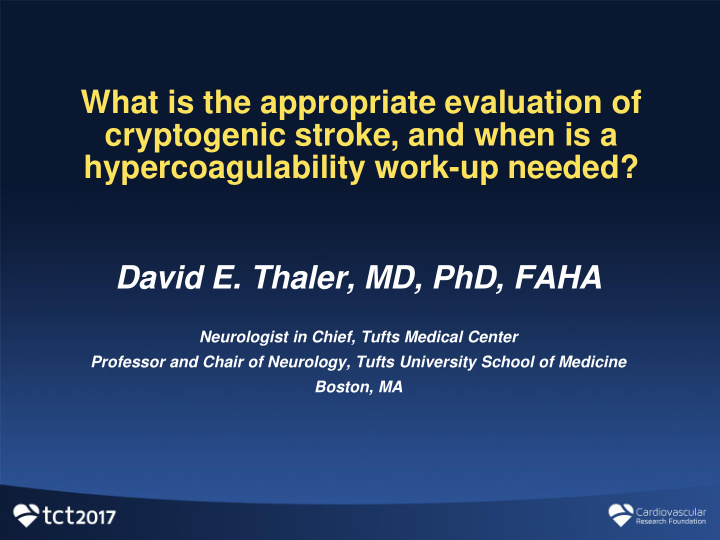



What is the appropriate evaluation of cryptogenic stroke, and when is a hypercoagulability work-up needed? David E. Thaler, MD, PhD, FAHA Neurologist in Chief, Tufts Medical Center Professor and Chair of Neurology, Tufts University School of Medicine Boston, MA
Disclosure Statement of Financial Interest Within the past 12 months, I have had a financial affiliation with the organization(s) listed below. Affiliation/Financial Relationship Company • Grant/Research Support • Steering Committee, • • Consulting Fees/Honoraria RESPECT Trial, Abbott • • Major Stock Shareholder/Equity • • Royalty Income • • • Ownership/Founder • • Intellectual Property Rights • Other All content provided by Dr David Thaler unless otherwise noted.
What is the appropriate evaluation of cryptogenic stroke, and when is a hypercoagulability work-up needed? David E. Thaler, MD, PhD, FAHA Neurologist in Chief, Tufts Medical Center Professor and Chair of Neurology, Tufts University School of Medicine Boston, MA
What is the appropriate evaluation of stroke, and when is a hypercoagulability work-up needed? David E. Thaler, MD, PhD, FAHA Neurologist in Chief, Tufts Medical Center Professor and Chair of Neurology, Tufts University School of Medicine Boston, MA
What is the underlying mechanism? “Stroke is an observation not a diagnosis”
Common mechanisms of cerebral ischemia • “Small vessel disease,” lacune (lipohyalinosis) • Embolism – Artery-to-artery (carotid, aorta, other) – Cardiac source – Paradoxical • Decreased perfusion through a fixed stenosis
Lacunar stroke (0.2-15mm 3 )
Large, old stroke
Other causes of cerebral ischemia • Vasculitis • Collagen vascular diseases: isolated angiitis of the CNS, temporal (giant cell) arteritis, polyarteritis nodosa, Wegener's granulomatosis, Takayasu's arteritis, syphilis • Meningitis : tuberculosis, fungi, syphilis, bacteria, herpes zoster • Arterial dissection: carotid, vertebral, basal intracranial arteries • Hematologic disorders: polycythemia, thrombocytosis, thrombotic thrombocytopenic purpura, disseminated intravascular coagulation, dysproteinemias, hemoglobinopathies (sickle cell disease) • Miscellaneous : cocaine, amphetamines, moyamoya disease, fibromuscular dysplasia, CADASIL • Hypercoagulable states : secondary to systemic disease, carcinoma (especially pancreatic), eclampsia, oral contraceptives, lupus, factor C or S deficiency, factor V mutation, etc. • V asospasm : following subarachnoid hemorrhage • Reversible cerebral vasoconstriction: idiopathic, migraine, eclampsia, trauma • Venous : Dehydration, pericranial infection, postpartum and postoperative states, systemic cancer
<50y 51-84y
• Arterial hypercoagulable testing – Lupus anticoagulant – Anticardiolipin Ab – Beta-2 glycoprotein – Homocysteine
If venous infarction or R-L shunt identified Arterial hypercoagulable testing • – Lupus anticoagulant – Anticardiolipin Ab – Beta-2 glycoprotein • Venous hypercoagulable testing – Homocysteine – Protein C, protein S, anti-thrombin III (RARE!) – Prothrombin gene mutation – Factor V Leiden (activated protein C resistance) – Factor VIII
If venous infarction or R-L shunt identified Arterial hypercoagulable testing • – Lupus anticoagulant – Anticardiolipin Ab – Beta-2 glycoprotein – Homocysteine Venous hypercoagulable testing • If unexplained – Protein C, protein S, anti-thrombin III (RARE!) – Prothrombin gene mutation – BILATERAL embolic Factor V Leiden (activated protein C resistance) – Factor VIII infarcts …
If venous infarction or R-L shunt identified Arterial hypercoagulable testing • – Lupus anticoagulant – Anticardiolipin Ab – Beta-2 glycoprotein – Homocysteine Venous hypercoagulable testing • If unexplained – Protein C, protein S, anti-thrombin III (RARE!) – Prothrombin gene mutation – BILATERAL embolic Factor V Leiden (activated protein C resistance) – Factor VIII infarcts … … cancer?
Stroke, cancer, d-dimer, and mortality Baseline d-dimer and mortality Journal of Stroke 2017 19(1) 77-87 Treated d-dimer and mortality
CONCLUSIONS • Rely on neurology to make a stroke diagnosis • Tailor testing to individual patient characteristics • Making a diagnosis is ”changing management”
Recommend
More recommend